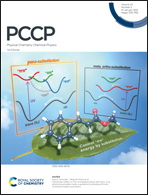Towards H2O catalyzed N2-fixation over TiO2 doped Run clusters (n = 5, 6): a mechanistic and kinetic approach†
Abstract
H2O driven N2 fixation is known as the best alternative pathway to synthesise NH3 under ambient conditions. The thermodynamic non-spontaneous reaction can be accomplished by a photocatalytic water splitting reaction over a TiO2 supported surface with oxygen vacancies. Previous experiments have also shown N2 activation over a neutral Ru cluster whose catalytic activity was remarkably enhanced by TiO2 doping. In this article, we have investigated the detailed mechanism and kinetics of the H2O catalyzed nitrogen reduction reaction (NRR) over bare and TiO2 doped Ru5 clusters in conjunction with DFT and TST calculations. The lack of photochemical activity of the small model cluster provoked us to explore an alternative route of NH3 formation via H2O catalysis. For this, we have considered H2 as co-reactant. The partial reduction of N2 into NH3 or N2H4 could be achieved by a H2O oxidation reaction, however, catalytic regeneration requires additional H2 which effectively makes the overall reaction catalyzed by H2O. Above all, the present investigation suggests that NH3 is most favorably produced through the distal mechanism. Analysis of the rate constants demonstrates that the doping with TiO2 accelerates the kinetics of NRR by a few orders of magnitude. Furthermore, an increase of the size of the metal cluster would not significantly enhance the overall performance of NRR.



 Please wait while we load your content...
Please wait while we load your content...